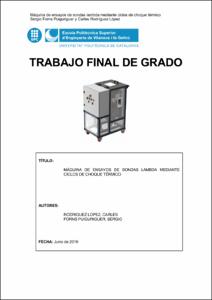Mostra el registre d'ítem simple
Máquina de ensayos de sondas lambda mediante ciclos de choque térmico
| dc.contributor | Sanz Collado, Gerard |
| dc.contributor.author | Rodríguez López, Carles |
| dc.contributor.author | Forns Puiguriguer, Sergio |
| dc.contributor.other | Universitat Politècnica de Catalunya. Departament d'Expressió Gràfica a l'Enginyeria |
| dc.date.accessioned | 2019-11-12T12:03:27Z |
| dc.date.available | 2019-11-12T12:03:27Z |
| dc.date.issued | 2019-07-04 |
| dc.identifier.uri | http://hdl.handle.net/2117/172224 |
| dc.description.abstract | [CASTELLÀ] Hoy en día la industria automovilística utiliza todos los conocimientos que a lo largo de los años el sector ha ido adquiriendo. Uno de los aspectos más importantes a tener en cuenta es la contaminación global. Es por ello que este sector está constantemente realizando investigaciones para reducir al máximo los gases contaminantes que los motores de combustión generan. Este proyecto consiste en la realización de una máquina de ensayo de sondas lambda o sensores de oxígeno, solicitada por un importante fabricante para cubrir sus necesidades. Dicho fabricante requiere comprobar la calidad de su producto estrella según normas de calidad internas especificadas por el propio cliente. El ensayo consiste en calentar los sensores de oxígeno hasta una temperatura de 400ºC y acto seguido refrigerarlas por agua, provocando así un choque térmico, repitiéndose este proceso durante un número determinado de ciclos. Dicho efecto simula el paso de un vehículo por encima de un charco o en condiciones de lluvia, ya que dichos sensores van instalados en el sistema de escape de todo tipo de vehículos de combustión. El proyecto incluye el diseño del sistema de control del proceso explicado, especificando los componentes elegidos y el motivo de su elección, así como el diseño mecánico de todo el sistema utilizando la herramienta CAD (Diseño por computación asistica) SolidWorks. Se muestran todas las cualidades y funcionalidades de la máquina mediante renderizados detallados del modelo 3D y se detallan todos los planos para su fabricación y ensamblaje. Aunque en el documento no se explica, el proyecto se ha llevado a cabo con éxito en la realidad y ha sido elaborado en paralelo al documento por los autores, lo que les proporciona una experiencia única y un primer contacto real con el mundo de la ingeniería industrial, lo que les aporta nuevas habilidades y conocimientos. |
| dc.description.abstract | [ANGLÈS] Nowadays, the automotive industry, make use of all the knowledge acquired along the years. One of the most important facts is the global pollution, and by this reason, the automotive industry is constantly improving and doing researches to reduce the pollution generated by the combustion engines. This project consists on the manufacturing of a lambda sensor or oxygen sensor machine test, asked by an important manufacturer to cover its necessities. This manufacturer requires checking the quality of its leading product, according to inner quality standards, specified by the manufacturer itself. The test consists on warming up the oxygen sensor up to 400ºC and suddenly splash water on it, causing an effect of thermal shock and repeating the process along a defined number of cycles. This effect simulates driving of a vehicle over a puddle or in rainy conditions. This is because these sensors are located on the exhaust system of all kind of combustion vehicles. The project includes the design of the control system of the explained process, specifying the chosen components and the reason of these decisions, as well as the mechanical design of the entire system, making use of the CAD (Computer assisted design) tool SolidWorks. The main functions and features of the machine have been explained with the help of rendered pictures of the 3D model and also all the drawings for its manufacturing and assembly are included. Even if it’s not explained in this document, the project has been done successfully in the reality, and has been developed in parallel by the authors. This gives to the authors a unique experience and a first real touch with the industrial engineering world, which provides them new skills and knowledge. |
| dc.language.iso | spa |
| dc.publisher | Universitat Politècnica de Catalunya |
| dc.rights | Attribution-ShareAlike 3.0 Spain |
| dc.rights.uri | http://creativecommons.org/licenses/by-sa/3.0/es/ |
| dc.subject | Àrees temàtiques de la UPC::Arquitectura::Disseny::Disseny industrial |
| dc.subject | Àrees temàtiques de la UPC::Enginyeria mecànica::Fabricació::Disseny i càlcul de màquines |
| dc.subject.lcsh | Automobile industry and trade |
| dc.subject.lcsh | Machine design |
| dc.subject.lcsh | Testing-machines |
| dc.subject.other | Lambda |
| dc.subject.other | Oxigeno |
| dc.subject.other | Ensayo |
| dc.subject.other | Escape |
| dc.subject.other | Diseño |
| dc.subject.other | Fabricación industrial |
| dc.subject.other | Automoción |
| dc.subject.other | Calidad |
| dc.subject.other | Control |
| dc.subject.other | Oxygen |
| dc.subject.other | Test |
| dc.subject.other | Exhaust |
| dc.subject.other | Design |
| dc.subject.other | Manufacturing |
| dc.subject.other | Automotive |
| dc.subject.other | Quality control |
| dc.title | Máquina de ensayos de sondas lambda mediante ciclos de choque térmico |
| dc.type | Bachelor thesis |
| dc.subject.lemac | Automòbils -- Indústria i comerç |
| dc.subject.lemac | Maquinària -- Disseny |
| dc.subject.lemac | Màquines d'assaig |
| dc.rights.access | Open Access |
| dc.audience.educationlevel | Grau |
| dc.audience.mediator | Escola Politècnica Superior d'Enginyeria de Vilanova i la Geltrú |
| dc.audience.degree | GRAU EN ENGINYERIA MECÀNICA (Pla 2009) |
| dc.contributor.covenantee | UMPI 3D |
| dc.contributor.covenantee | Francisco Albero |






